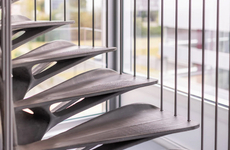
ETH Zurich Developed an Ultra-Lightweight 3D-Printed Canoe
Laura McQuarrie — June 15, 2017 — Eco
References: dbt.arch.ethz.ch & 3ders.org
Although the idea of using concrete for the creation of a watercraft that is designed to stay afloat might seem counterintuitive, ETH Zurich recently received a Design Innovation award at the 26th Concrete Canoe Regatta for its 3D-printed canoe design made with this material.
As part of the 26th Concrete Canoe Regatta, participants were challenged to create a concrete canoe that could successfully be sent down a river. The winning design, dubbed 'SkelETHon,' boasts a skeletal structure with "bones" cast in fiber-reinforced concrete. In all, the skeletal framework of the canoe weighs just four kilograms and boasts a three-millimeter-thick waterproof skin.
The design of this structure speaks to the great potential for 3D printing to be used to its fullest to recreate innovative new forms in the world of transportation, architecture and beyond.
As part of the 26th Concrete Canoe Regatta, participants were challenged to create a concrete canoe that could successfully be sent down a river. The winning design, dubbed 'SkelETHon,' boasts a skeletal structure with "bones" cast in fiber-reinforced concrete. In all, the skeletal framework of the canoe weighs just four kilograms and boasts a three-millimeter-thick waterproof skin.
The design of this structure speaks to the great potential for 3D printing to be used to its fullest to recreate innovative new forms in the world of transportation, architecture and beyond.
Trend Themes
1. 3D Printing in Transportation - The use of 3D printing in transportation opens up opportunities for creating innovative and lightweight structures that can enhance fuel efficiency and reduce material waste.
2. Advanced Materials in Architecture - Using advanced materials, such as fiber-reinforced concrete, in architecture allows for the creation of durable and sustainable structures with unique designs and properties.
3. Innovative Construction Techniques - Exploring innovative construction techniques, such as 3D printing, enables the development of cost-effective and customizable solutions that can revolutionize the construction industry.
Industry Implications
1. Transportation - The transportation industry can benefit from adopting 3D printing technology to create lightweight and fuel-efficient vehicles.
2. Architecture - The architecture industry can leverage advanced materials and 3D printing techniques to build sustainable and aesthetically pleasing structures.
3. Construction - The construction industry can embrace innovative construction techniques, like 3D printing, to enhance productivity and reduce material waste.
5.7
Score
Popularity
Activity
Freshness























